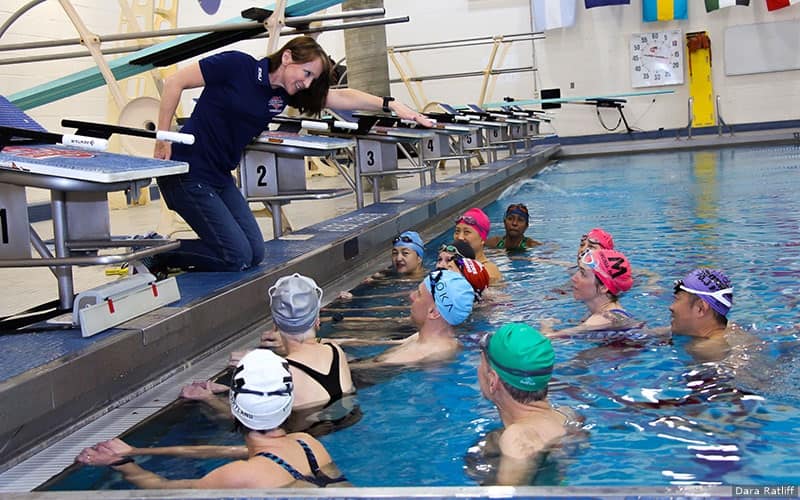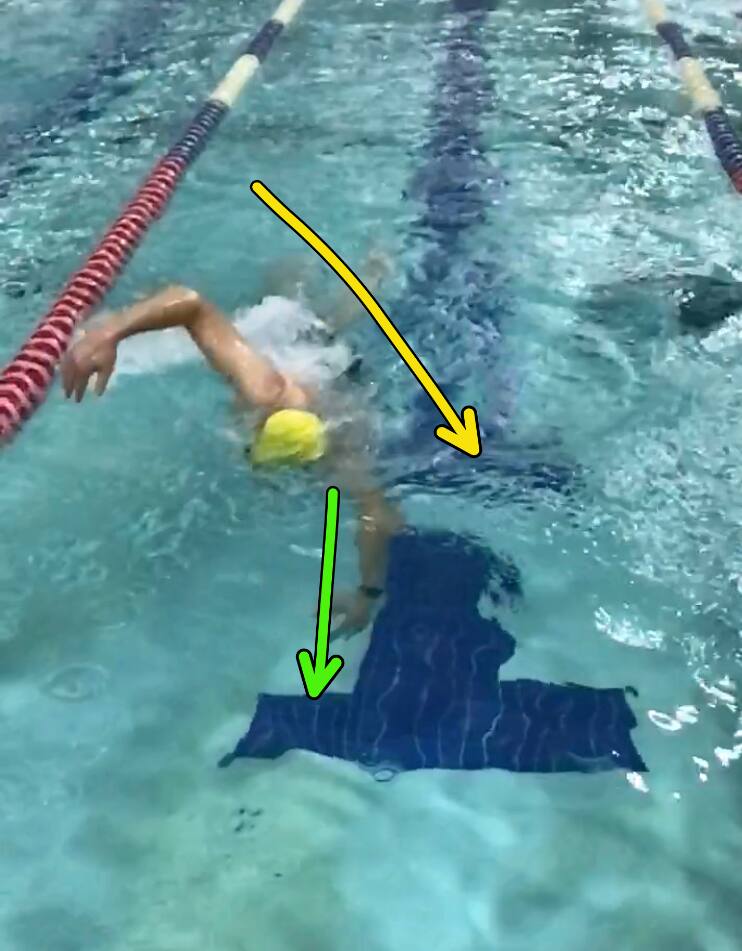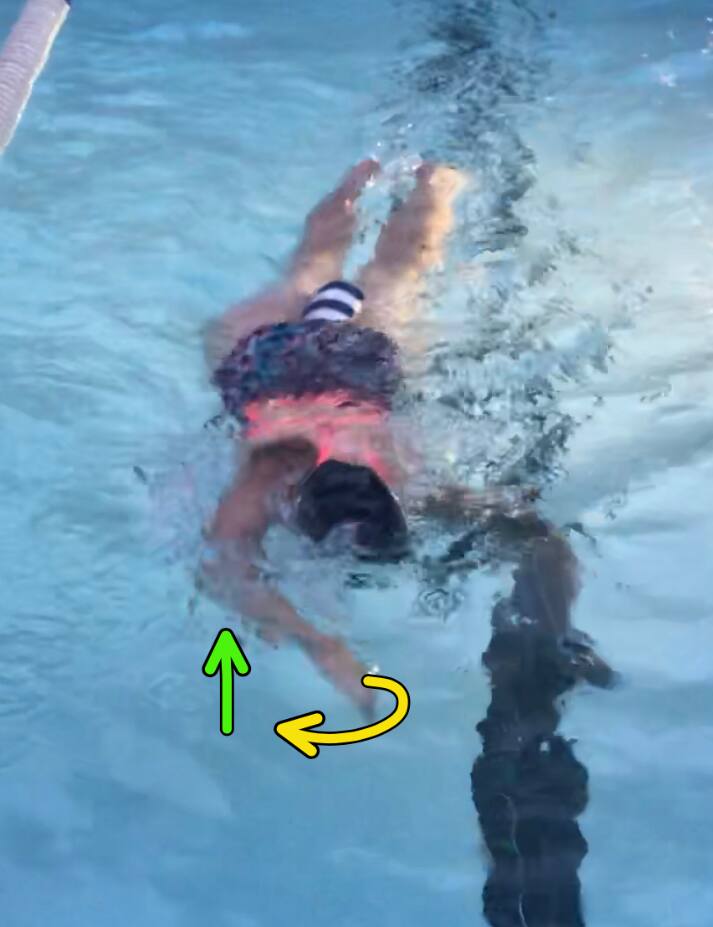
10 Common Freestyle Swim Mistakes and How to Correct Them
by Christina Dorrer

From the pool deck, a coach can quickly identify flaws in a swimmer’s freestyle stroke.
Even as a fairly strong swimmer myself, it was not until I recently had my own stroke recorded by video that I realized I have a couple of flaws I need to correct. It is a good idea, even for the best freestyle swimmers, to occasionally have your stroke analyzed by video and reviewed by a coach to catch mistakes. Making even the smallest changes can help one become more efficient and swim faster through the water.
Below, you'll find photos showing common mistakes a swim coach might identify. The yellow line indicates what the swimmer is doing incorrectly. The green line shows the direction the swimmer should be moving.
Read on to see my tips for how to correct the mistakes.
Keep in mind, changing your stroke often takes a long time and a lot of practice. Regular use of the correct drills should eventually allow muscle memory to move the body naturally in the proper position.

The mistake: Here, the swimmer is entering their left arm into the water and crossing an imaginary midline of the body. Most swimmers who do this do not even realize it. Those who cross the midline of the body upon entry risk shoulder injury and are less efficient.
The fix: Imagine being a clock and aim your fingers for 11:30 and 12:30 on the clock. If you continue to cross, aim for 11 and 1 on the clock. Sometimes, the swimmer will also need to straighten the elbow slightly.

The mistake: Here, the swimmer is seen with the elbow dropping well below the wrist and hand. This makes for an inefficient start to the catch and pull phases of the stroke. Sometimes a swimmer’s fingertips are seen breaking the surface of the water while the elbow drops down.
The fix: Swimmers should think about aiming deeper into the water rather than for the surface. Fingertips should always be below the wrist, wrist below the elbow, and elbow below the shoulder. Also, be sure not to over-rotate which drops the shoulder too deep into the water and can cause the hand to rise above the elbow.

The mistake: Here, the swimmer is seen starting the pull too soon and their arms are moving exactly opposite of each other like a fan or a windmill.
The fix: The catch-up drill is great for fixing this mistake. It will help with the timing of the stroke and breath, which are usually both incorrectly timed with windmill swimmers.
The swimmer should practice keeping one arm straight out in streamline until the other hand catches up to meet it before initiating the next stroke. The catch-up drill can also be done as a one-arm-only drill where the swimmer keeps one arm stationary in streamline and uses only the other to swim across the pool.
I have my swimmers practice this on both sides to become comfortable at breathing on the right and left, and to balance out strength deficiencies.

The mistake: The swimmer in this picture is entering the water then internally rotating their arm to push the water to the side instead of pulling it back. Fingertips should enter reaching straight ahead in streamline with the palm facing down. Then, the fingers should point directly to the bottom of the pool as the elbow bends in the catch and pull phases of the stroke.
The fix: The swimmer should imagine pulling themselves to move in front of the water rather than pushing the water behind them. In other words, imagine your hand, with fingers to the floor, anchored into place while you engage your back muscles to hurl the body in front of the hand. This will yield stronger, faster results than using weaker arm and shoulder muscles to push the water back.

The mistake: This swimmer has a straight, long arm during the pull phase of the stroke as though he is reaching for the bottom of the pool. This slows the swimmer by creating drag. In addition, the swimmer is missing out on power generated by using strong muscles in the back.
The fix: Imagine swimming in very shallow water with lots of seaweed at the bottom. If you don’t want to touch the seaweed, you need to bend the elbows at 90 degrees. Do this early in the stroke for a stronger pull. In other words, maintain an early vertical forearm.

The mistake: An S-curve was once taught as the proper way to pull (or so I am told!). This instructed the swimmer to pull under the body making an “S” shape with the hand rather than pulling straight back. I often see swimmers with an S-curve who also cross the midline of the body beneath them.
The fix: For a more efficient stroke, S-curve swimmers should think about pointing their fingers to the floor while keeping a 90-degree bend in the elbow. Then, they should think about pulling straight back and avoid the hand going under the belly. A helpful drill is scraping your thigh with your thumb with each stroke.

The mistake: A swimmer is over rotating when one shoulder goes too deep in the water and/or their entire face is exposed on the breath.
The fix: Taking less time on the breath and refraining from pulling too early will help prevent over-rotation of the head and body during breathing. In addition, one of the goggles should be in the water and the top of the head should be down. When taking the breath, aim the mouth and chin back towards the armpit rather than to the side.

The mistake: When a swimmer lifts their head to breathe, the legs sink and create a huge amount of drag.
The fix: Imagine being a pencil. Your head is the eraser and your feet are the point. When you breathe, since the eraser cannot lift, you must rotate the pencil (head, shoulders and hips) together simultaneously. This helps keep the top of the head down during the breath and allows the legs to stay up higher. Just be sure not to over rotate like the swimmer in No. 7.

The mistake: Swimmers who open their legs like a pair of scissors during the kick are creating a lot of drag. Usually, this is caused from being off balance which is the result of incorrect positioning and timing of the stroke. Most novice swimmers maintain the same (slow) rate of arm movement throughout the entire stroke. Their arms windmill and their legs scissor to help them feel more balanced.
The fix: Fixing this requires use of most of the tips mentioned above (especially Nos. 3 and 7), but also altering the arm speed as it enters and exits the water. Accelerate the arm into the water, then accelerate back. A slower movement is used in the recovery phase. The arms should not move in constant rhythm like the second hands of a clock.

The mistake: Even good swimmers miss out on a lot of power during the push phase of the stroke by pulling the arm into recovery too early.
The fix: Practice flicking water into the air at the end of your stroke by your thigh to remember to finish. Also, counting your strokes across the pool and attempting to decrease the number while increasing your distance per stroke is a good drill for learning to finish the stroke. Middle and long distance swimmers benefit most from finishing this push phase.
Christina Dorrer is a USAT L2, Youth & Junior, Ironman, USAC L3 and USMS certified coach. In addition to organizing triathlon specific classes and clinics, she privately coaches beginner and world champion athletes. She is also the head coach for Endurance 2 Perform℠ Multisport Coaching Group and Fit 2 B Kids Multisport Team out of Rockville, Maryland. She can be reached at www.Endurance2Perform.com.
The views expressed in this article are the opinion of the author and not necessarily the practices of USA Triathlon. Before starting any new diet or exercise program, you should check with your physician and/or coach.